Analyzing the Novice to Expert Model
VerifiedAdded on 2023/06/03
|7
|1660
|423
AI Summary
This article analyzes Benner's Novice to Expert Model in nursing, highlighting the five levels of skill acquisition advancement and the importance of clinical experience in developing professionals.
Contribute Materials
Your contribution can guide someone’s learning journey. Share your
documents today.
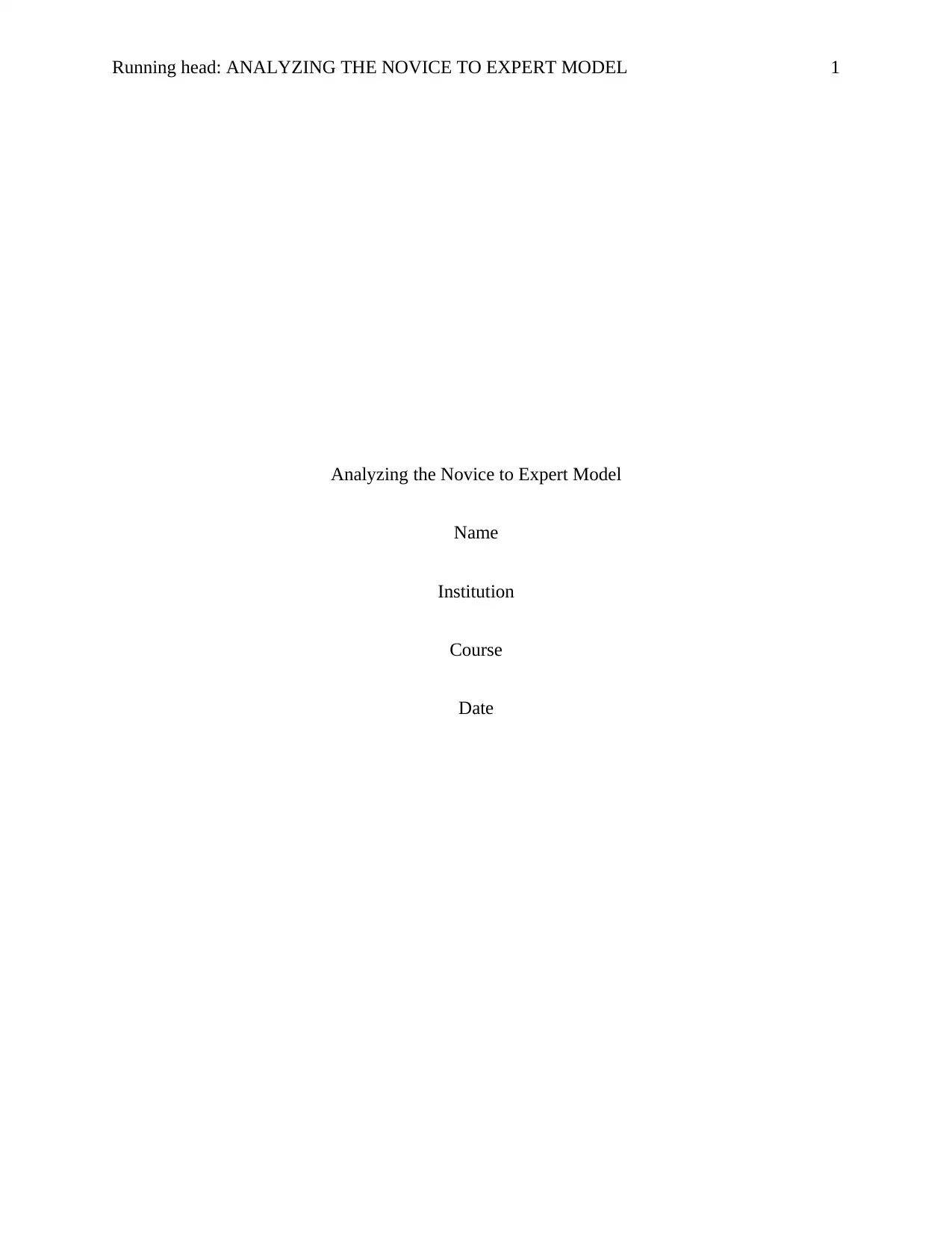
Running head: ANALYZING THE NOVICE TO EXPERT MODEL 1
Analyzing the Novice to Expert Model
Name
Institution
Course
Date
Analyzing the Novice to Expert Model
Name
Institution
Course
Date
Secure Best Marks with AI Grader
Need help grading? Try our AI Grader for instant feedback on your assignments.
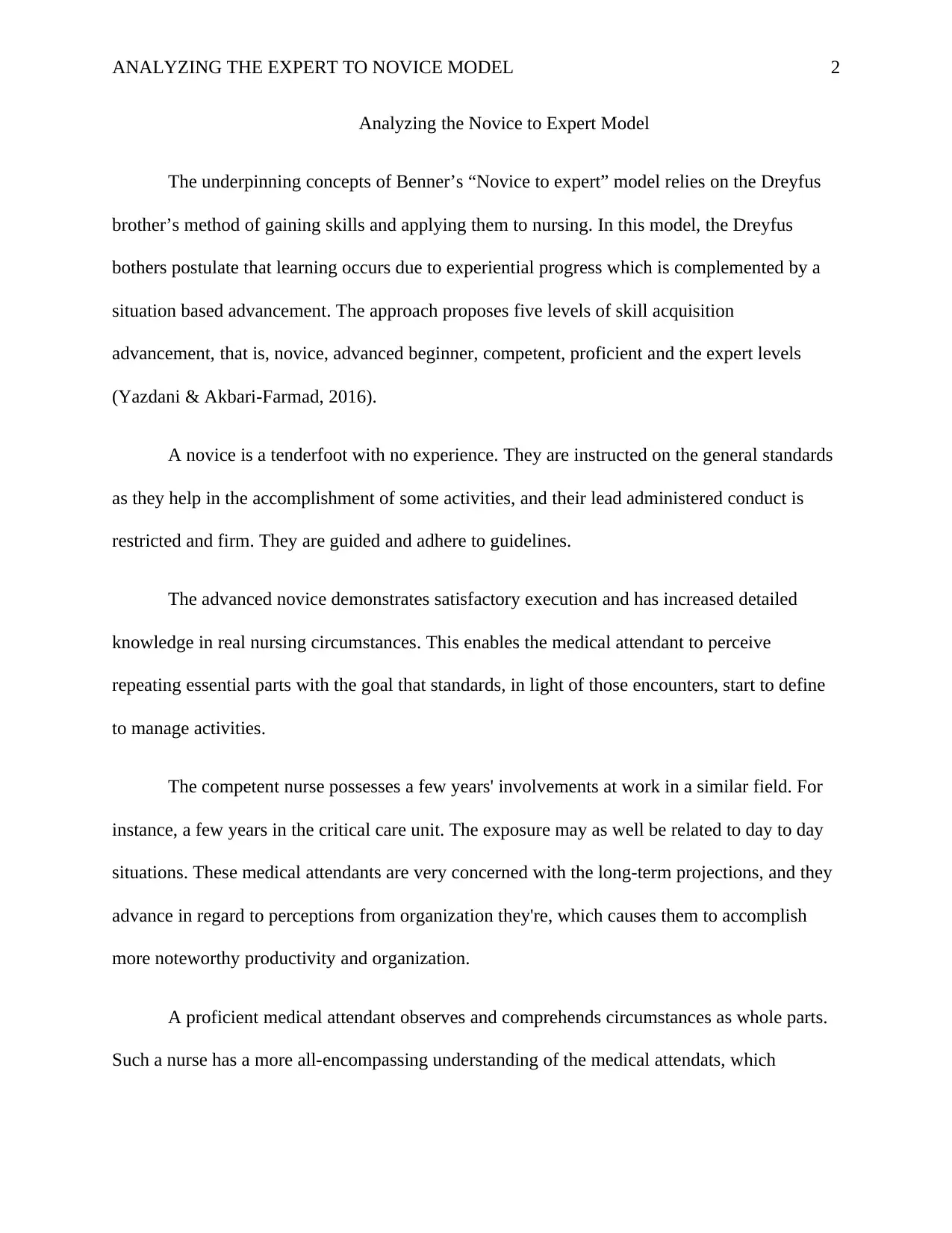
ANALYZING THE EXPERT TO NOVICE MODEL 2
Analyzing the Novice to Expert Model
The underpinning concepts of Benner’s “Novice to expert” model relies on the Dreyfus
brother’s method of gaining skills and applying them to nursing. In this model, the Dreyfus
bothers postulate that learning occurs due to experiential progress which is complemented by a
situation based advancement. The approach proposes five levels of skill acquisition
advancement, that is, novice, advanced beginner, competent, proficient and the expert levels
(Yazdani & Akbari-Farmad, 2016).
A novice is a tenderfoot with no experience. They are instructed on the general standards
as they help in the accomplishment of some activities, and their lead administered conduct is
restricted and firm. They are guided and adhere to guidelines.
The advanced novice demonstrates satisfactory execution and has increased detailed
knowledge in real nursing circumstances. This enables the medical attendant to perceive
repeating essential parts with the goal that standards, in light of those encounters, start to define
to manage activities.
The competent nurse possesses a few years' involvements at work in a similar field. For
instance, a few years in the critical care unit. The exposure may as well be related to day to day
situations. These medical attendants are very concerned with the long-term projections, and they
advance in regard to perceptions from organization they're, which causes them to accomplish
more noteworthy productivity and organization.
A proficient medical attendant observes and comprehends circumstances as whole parts.
Such a nurse has a more all-encompassing understanding of the medical attendats, which
Analyzing the Novice to Expert Model
The underpinning concepts of Benner’s “Novice to expert” model relies on the Dreyfus
brother’s method of gaining skills and applying them to nursing. In this model, the Dreyfus
bothers postulate that learning occurs due to experiential progress which is complemented by a
situation based advancement. The approach proposes five levels of skill acquisition
advancement, that is, novice, advanced beginner, competent, proficient and the expert levels
(Yazdani & Akbari-Farmad, 2016).
A novice is a tenderfoot with no experience. They are instructed on the general standards
as they help in the accomplishment of some activities, and their lead administered conduct is
restricted and firm. They are guided and adhere to guidelines.
The advanced novice demonstrates satisfactory execution and has increased detailed
knowledge in real nursing circumstances. This enables the medical attendant to perceive
repeating essential parts with the goal that standards, in light of those encounters, start to define
to manage activities.
The competent nurse possesses a few years' involvements at work in a similar field. For
instance, a few years in the critical care unit. The exposure may as well be related to day to day
situations. These medical attendants are very concerned with the long-term projections, and they
advance in regard to perceptions from organization they're, which causes them to accomplish
more noteworthy productivity and organization.
A proficient medical attendant observes and comprehends circumstances as whole parts.
Such a nurse has a more all-encompassing understanding of the medical attendats, which
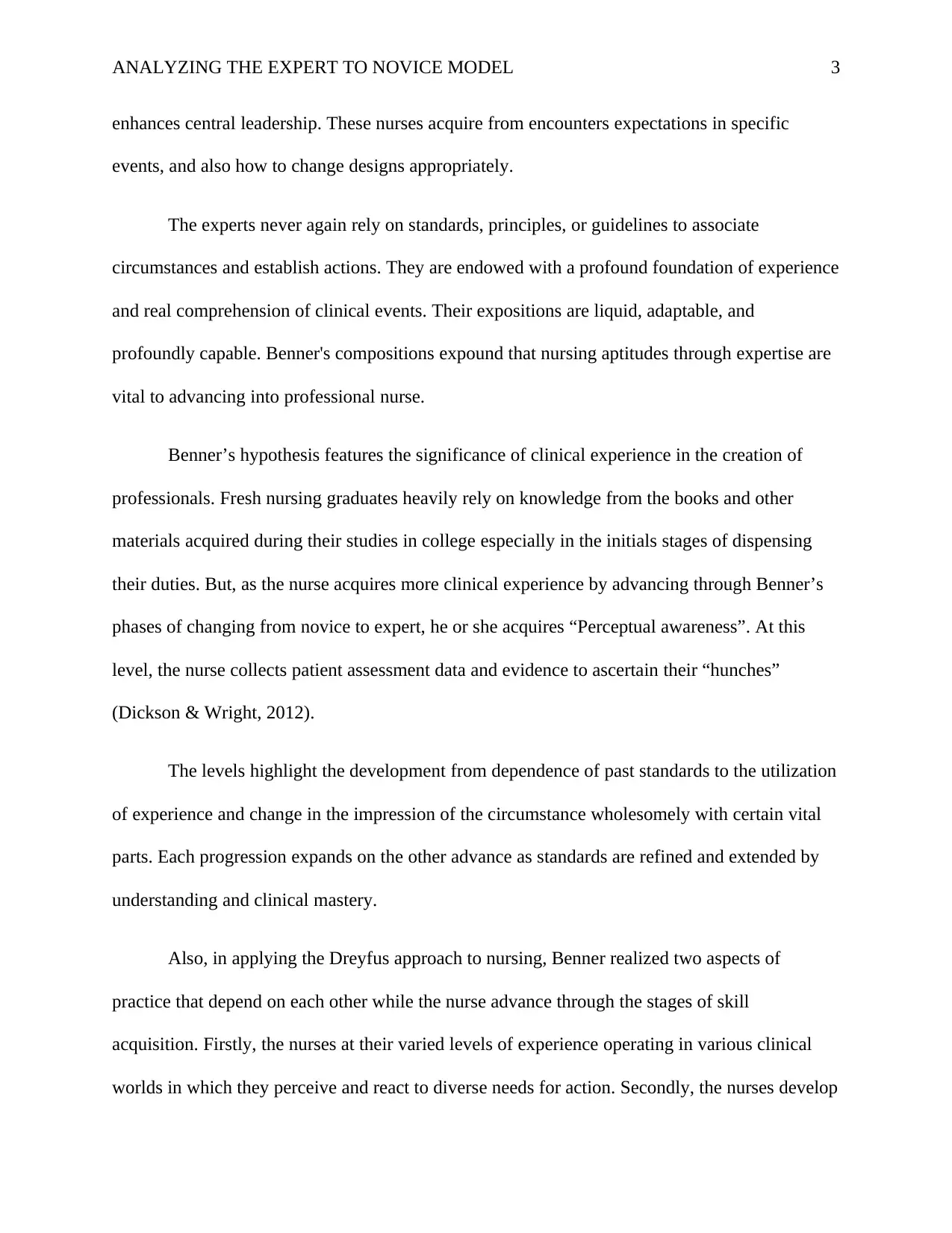
ANALYZING THE EXPERT TO NOVICE MODEL 3
enhances central leadership. These nurses acquire from encounters expectations in specific
events, and also how to change designs appropriately.
The experts never again rely on standards, principles, or guidelines to associate
circumstances and establish actions. They are endowed with a profound foundation of experience
and real comprehension of clinical events. Their expositions are liquid, adaptable, and
profoundly capable. Benner's compositions expound that nursing aptitudes through expertise are
vital to advancing into professional nurse.
Benner’s hypothesis features the significance of clinical experience in the creation of
professionals. Fresh nursing graduates heavily rely on knowledge from the books and other
materials acquired during their studies in college especially in the initials stages of dispensing
their duties. But, as the nurse acquires more clinical experience by advancing through Benner’s
phases of changing from novice to expert, he or she acquires “Perceptual awareness”. At this
level, the nurse collects patient assessment data and evidence to ascertain their “hunches”
(Dickson & Wright, 2012).
The levels highlight the development from dependence of past standards to the utilization
of experience and change in the impression of the circumstance wholesomely with certain vital
parts. Each progression expands on the other advance as standards are refined and extended by
understanding and clinical mastery.
Also, in applying the Dreyfus approach to nursing, Benner realized two aspects of
practice that depend on each other while the nurse advance through the stages of skill
acquisition. Firstly, the nurses at their varied levels of experience operating in various clinical
worlds in which they perceive and react to diverse needs for action. Secondly, the nurses develop
enhances central leadership. These nurses acquire from encounters expectations in specific
events, and also how to change designs appropriately.
The experts never again rely on standards, principles, or guidelines to associate
circumstances and establish actions. They are endowed with a profound foundation of experience
and real comprehension of clinical events. Their expositions are liquid, adaptable, and
profoundly capable. Benner's compositions expound that nursing aptitudes through expertise are
vital to advancing into professional nurse.
Benner’s hypothesis features the significance of clinical experience in the creation of
professionals. Fresh nursing graduates heavily rely on knowledge from the books and other
materials acquired during their studies in college especially in the initials stages of dispensing
their duties. But, as the nurse acquires more clinical experience by advancing through Benner’s
phases of changing from novice to expert, he or she acquires “Perceptual awareness”. At this
level, the nurse collects patient assessment data and evidence to ascertain their “hunches”
(Dickson & Wright, 2012).
The levels highlight the development from dependence of past standards to the utilization
of experience and change in the impression of the circumstance wholesomely with certain vital
parts. Each progression expands on the other advance as standards are refined and extended by
understanding and clinical mastery.
Also, in applying the Dreyfus approach to nursing, Benner realized two aspects of
practice that depend on each other while the nurse advance through the stages of skill
acquisition. Firstly, the nurses at their varied levels of experience operating in various clinical
worlds in which they perceive and react to diverse needs for action. Secondly, the nurses develop
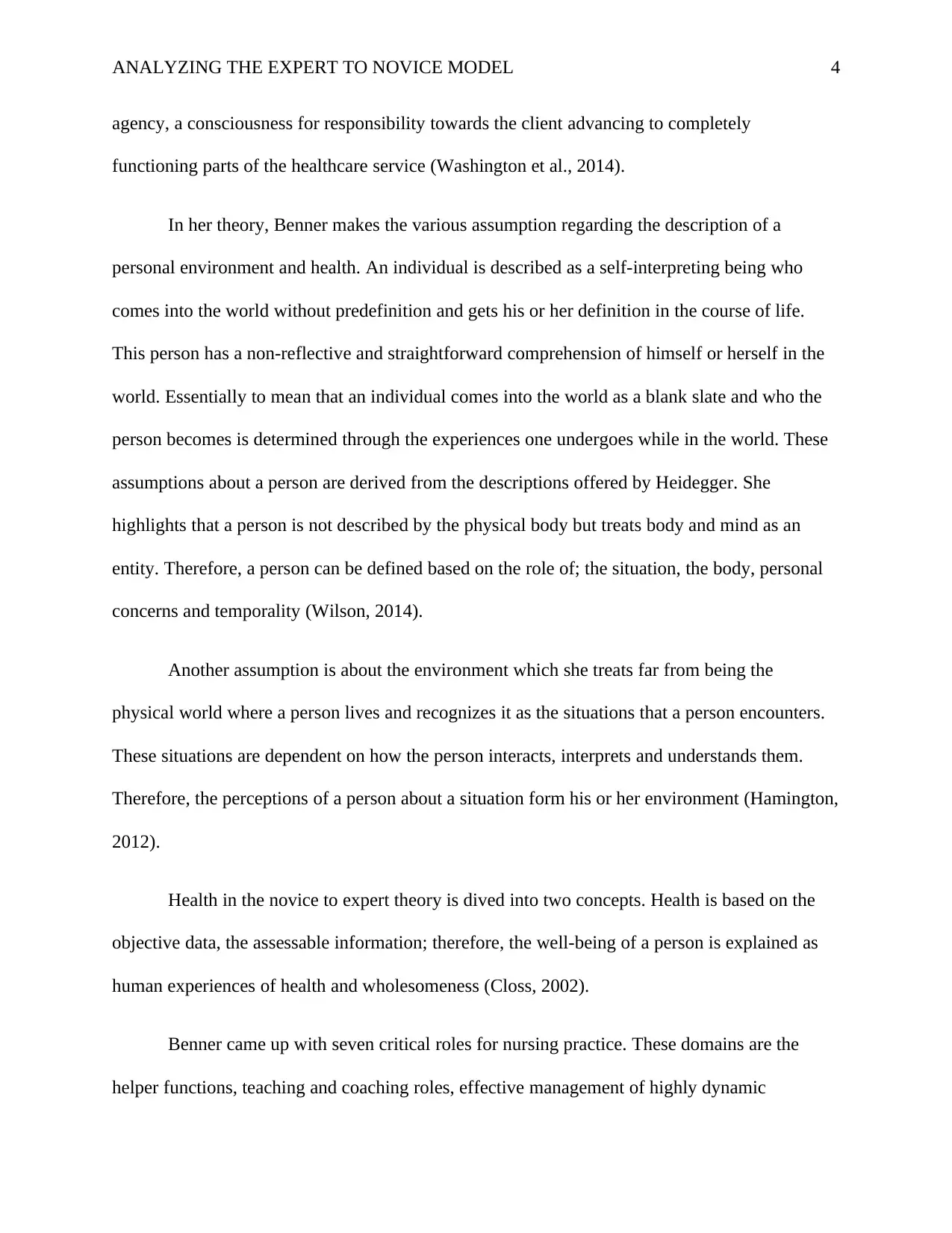
ANALYZING THE EXPERT TO NOVICE MODEL 4
agency, a consciousness for responsibility towards the client advancing to completely
functioning parts of the healthcare service (Washington et al., 2014).
In her theory, Benner makes the various assumption regarding the description of a
personal environment and health. An individual is described as a self-interpreting being who
comes into the world without predefinition and gets his or her definition in the course of life.
This person has a non-reflective and straightforward comprehension of himself or herself in the
world. Essentially to mean that an individual comes into the world as a blank slate and who the
person becomes is determined through the experiences one undergoes while in the world. These
assumptions about a person are derived from the descriptions offered by Heidegger. She
highlights that a person is not described by the physical body but treats body and mind as an
entity. Therefore, a person can be defined based on the role of; the situation, the body, personal
concerns and temporality (Wilson, 2014).
Another assumption is about the environment which she treats far from being the
physical world where a person lives and recognizes it as the situations that a person encounters.
These situations are dependent on how the person interacts, interprets and understands them.
Therefore, the perceptions of a person about a situation form his or her environment (Hamington,
2012).
Health in the novice to expert theory is dived into two concepts. Health is based on the
objective data, the assessable information; therefore, the well-being of a person is explained as
human experiences of health and wholesomeness (Closs, 2002).
Benner came up with seven critical roles for nursing practice. These domains are the
helper functions, teaching and coaching roles, effective management of highly dynamic
agency, a consciousness for responsibility towards the client advancing to completely
functioning parts of the healthcare service (Washington et al., 2014).
In her theory, Benner makes the various assumption regarding the description of a
personal environment and health. An individual is described as a self-interpreting being who
comes into the world without predefinition and gets his or her definition in the course of life.
This person has a non-reflective and straightforward comprehension of himself or herself in the
world. Essentially to mean that an individual comes into the world as a blank slate and who the
person becomes is determined through the experiences one undergoes while in the world. These
assumptions about a person are derived from the descriptions offered by Heidegger. She
highlights that a person is not described by the physical body but treats body and mind as an
entity. Therefore, a person can be defined based on the role of; the situation, the body, personal
concerns and temporality (Wilson, 2014).
Another assumption is about the environment which she treats far from being the
physical world where a person lives and recognizes it as the situations that a person encounters.
These situations are dependent on how the person interacts, interprets and understands them.
Therefore, the perceptions of a person about a situation form his or her environment (Hamington,
2012).
Health in the novice to expert theory is dived into two concepts. Health is based on the
objective data, the assessable information; therefore, the well-being of a person is explained as
human experiences of health and wholesomeness (Closs, 2002).
Benner came up with seven critical roles for nursing practice. These domains are the
helper functions, teaching and coaching roles, effective management of highly dynamic
Secure Best Marks with AI Grader
Need help grading? Try our AI Grader for instant feedback on your assignments.
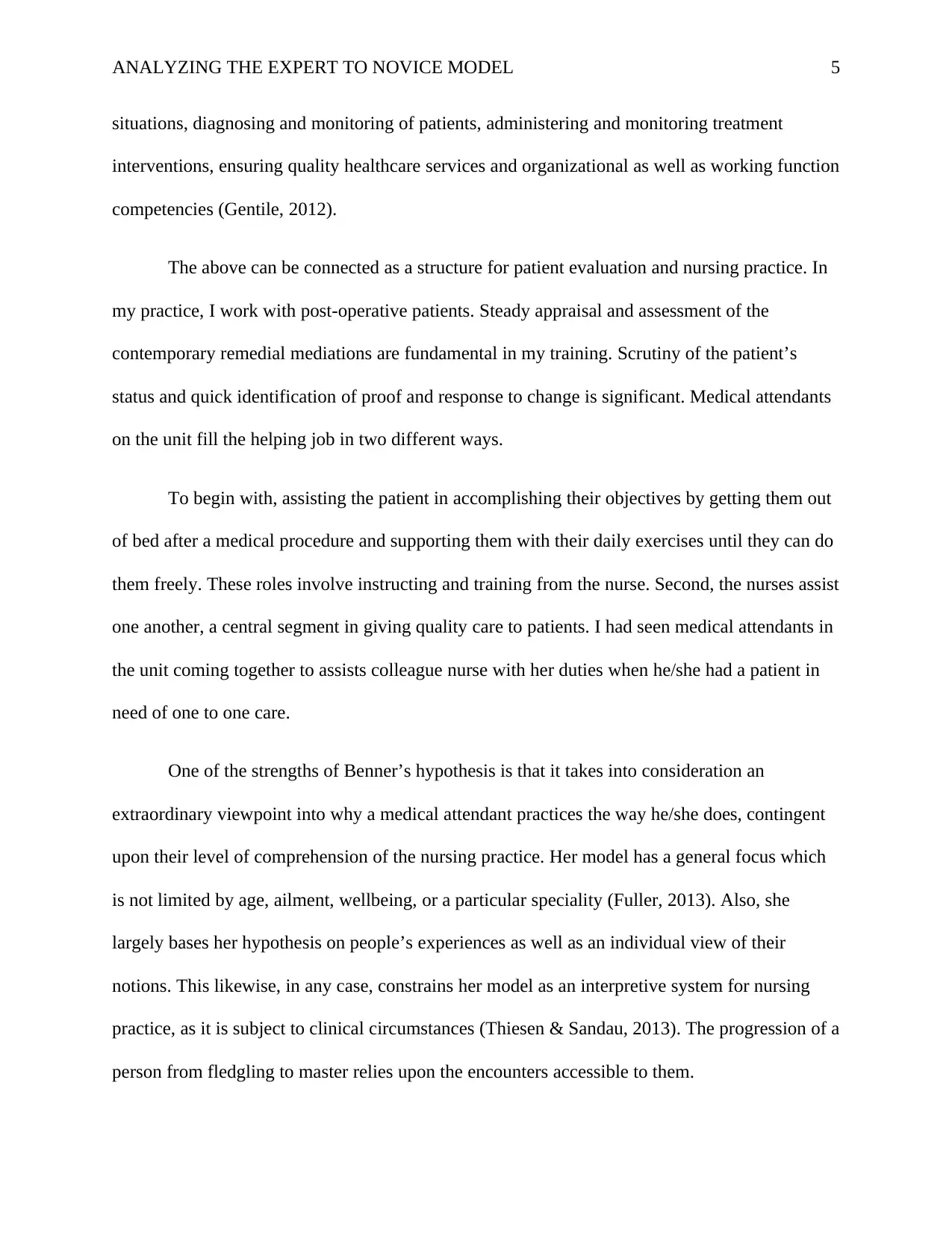
ANALYZING THE EXPERT TO NOVICE MODEL 5
situations, diagnosing and monitoring of patients, administering and monitoring treatment
interventions, ensuring quality healthcare services and organizational as well as working function
competencies (Gentile, 2012).
The above can be connected as a structure for patient evaluation and nursing practice. In
my practice, I work with post-operative patients. Steady appraisal and assessment of the
contemporary remedial mediations are fundamental in my training. Scrutiny of the patient’s
status and quick identification of proof and response to change is significant. Medical attendants
on the unit fill the helping job in two different ways.
To begin with, assisting the patient in accomplishing their objectives by getting them out
of bed after a medical procedure and supporting them with their daily exercises until they can do
them freely. These roles involve instructing and training from the nurse. Second, the nurses assist
one another, a central segment in giving quality care to patients. I had seen medical attendants in
the unit coming together to assists colleague nurse with her duties when he/she had a patient in
need of one to one care.
One of the strengths of Benner’s hypothesis is that it takes into consideration an
extraordinary viewpoint into why a medical attendant practices the way he/she does, contingent
upon their level of comprehension of the nursing practice. Her model has a general focus which
is not limited by age, ailment, wellbeing, or a particular speciality (Fuller, 2013). Also, she
largely bases her hypothesis on people’s experiences as well as an individual view of their
notions. This likewise, in any case, constrains her model as an interpretive system for nursing
practice, as it is subject to clinical circumstances (Thiesen & Sandau, 2013). The progression of a
person from fledgling to master relies upon the encounters accessible to them.
situations, diagnosing and monitoring of patients, administering and monitoring treatment
interventions, ensuring quality healthcare services and organizational as well as working function
competencies (Gentile, 2012).
The above can be connected as a structure for patient evaluation and nursing practice. In
my practice, I work with post-operative patients. Steady appraisal and assessment of the
contemporary remedial mediations are fundamental in my training. Scrutiny of the patient’s
status and quick identification of proof and response to change is significant. Medical attendants
on the unit fill the helping job in two different ways.
To begin with, assisting the patient in accomplishing their objectives by getting them out
of bed after a medical procedure and supporting them with their daily exercises until they can do
them freely. These roles involve instructing and training from the nurse. Second, the nurses assist
one another, a central segment in giving quality care to patients. I had seen medical attendants in
the unit coming together to assists colleague nurse with her duties when he/she had a patient in
need of one to one care.
One of the strengths of Benner’s hypothesis is that it takes into consideration an
extraordinary viewpoint into why a medical attendant practices the way he/she does, contingent
upon their level of comprehension of the nursing practice. Her model has a general focus which
is not limited by age, ailment, wellbeing, or a particular speciality (Fuller, 2013). Also, she
largely bases her hypothesis on people’s experiences as well as an individual view of their
notions. This likewise, in any case, constrains her model as an interpretive system for nursing
practice, as it is subject to clinical circumstances (Thiesen & Sandau, 2013). The progression of a
person from fledgling to master relies upon the encounters accessible to them.
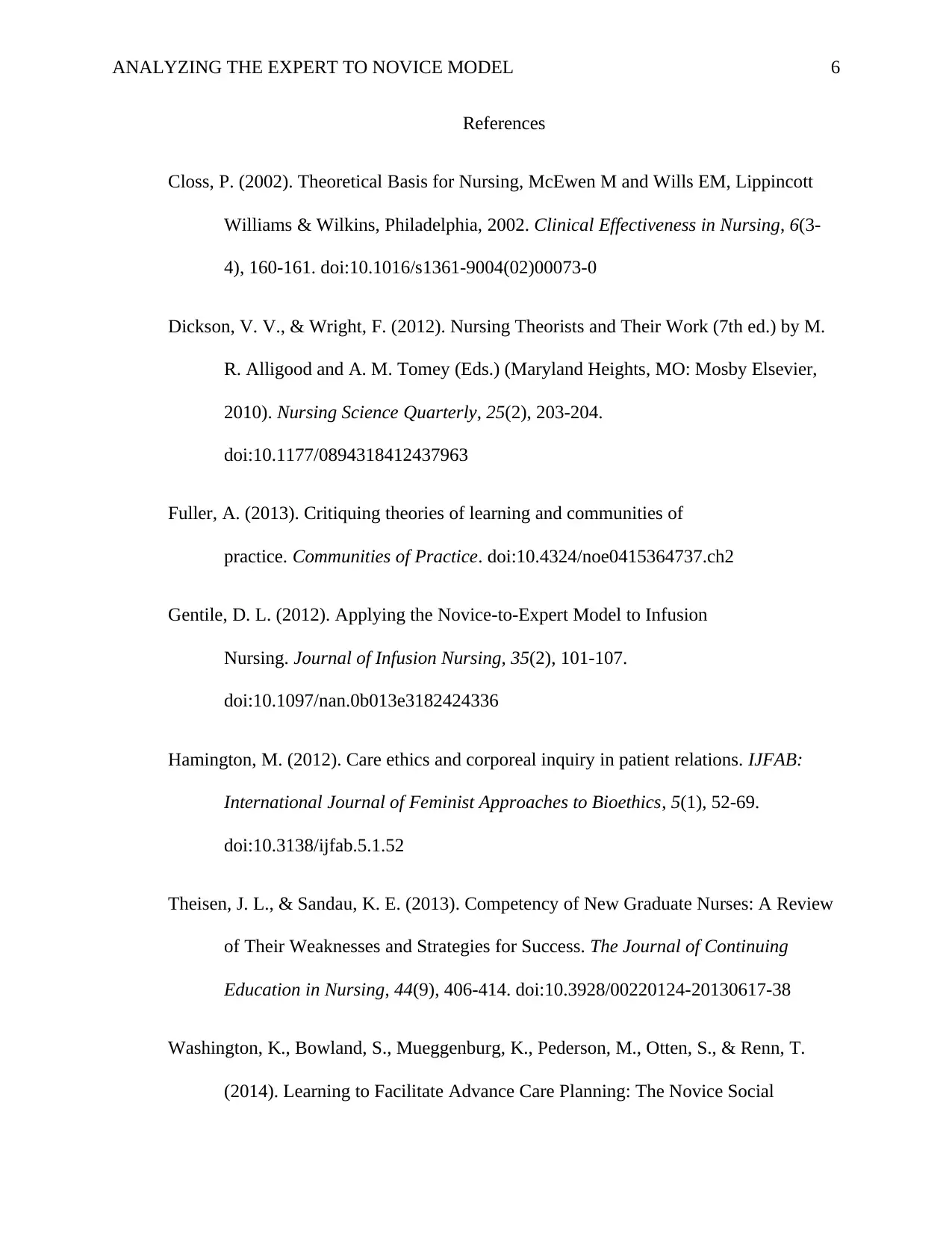
ANALYZING THE EXPERT TO NOVICE MODEL 6
References
Closs, P. (2002). Theoretical Basis for Nursing, McEwen M and Wills EM, Lippincott
Williams & Wilkins, Philadelphia, 2002. Clinical Effectiveness in Nursing, 6(3-
4), 160-161. doi:10.1016/s1361-9004(02)00073-0
Dickson, V. V., & Wright, F. (2012). Nursing Theorists and Their Work (7th ed.) by M.
R. Alligood and A. M. Tomey (Eds.) (Maryland Heights, MO: Mosby Elsevier,
2010). Nursing Science Quarterly, 25(2), 203-204.
doi:10.1177/0894318412437963
Fuller, A. (2013). Critiquing theories of learning and communities of
practice. Communities of Practice. doi:10.4324/noe0415364737.ch2
Gentile, D. L. (2012). Applying the Novice-to-Expert Model to Infusion
Nursing. Journal of Infusion Nursing, 35(2), 101-107.
doi:10.1097/nan.0b013e3182424336
Hamington, M. (2012). Care ethics and corporeal inquiry in patient relations. IJFAB:
International Journal of Feminist Approaches to Bioethics, 5(1), 52-69.
doi:10.3138/ijfab.5.1.52
Theisen, J. L., & Sandau, K. E. (2013). Competency of New Graduate Nurses: A Review
of Their Weaknesses and Strategies for Success. The Journal of Continuing
Education in Nursing, 44(9), 406-414. doi:10.3928/00220124-20130617-38
Washington, K., Bowland, S., Mueggenburg, K., Pederson, M., Otten, S., & Renn, T.
(2014). Learning to Facilitate Advance Care Planning: The Novice Social
References
Closs, P. (2002). Theoretical Basis for Nursing, McEwen M and Wills EM, Lippincott
Williams & Wilkins, Philadelphia, 2002. Clinical Effectiveness in Nursing, 6(3-
4), 160-161. doi:10.1016/s1361-9004(02)00073-0
Dickson, V. V., & Wright, F. (2012). Nursing Theorists and Their Work (7th ed.) by M.
R. Alligood and A. M. Tomey (Eds.) (Maryland Heights, MO: Mosby Elsevier,
2010). Nursing Science Quarterly, 25(2), 203-204.
doi:10.1177/0894318412437963
Fuller, A. (2013). Critiquing theories of learning and communities of
practice. Communities of Practice. doi:10.4324/noe0415364737.ch2
Gentile, D. L. (2012). Applying the Novice-to-Expert Model to Infusion
Nursing. Journal of Infusion Nursing, 35(2), 101-107.
doi:10.1097/nan.0b013e3182424336
Hamington, M. (2012). Care ethics and corporeal inquiry in patient relations. IJFAB:
International Journal of Feminist Approaches to Bioethics, 5(1), 52-69.
doi:10.3138/ijfab.5.1.52
Theisen, J. L., & Sandau, K. E. (2013). Competency of New Graduate Nurses: A Review
of Their Weaknesses and Strategies for Success. The Journal of Continuing
Education in Nursing, 44(9), 406-414. doi:10.3928/00220124-20130617-38
Washington, K., Bowland, S., Mueggenburg, K., Pederson, M., Otten, S., & Renn, T.
(2014). Learning to Facilitate Advance Care Planning: The Novice Social
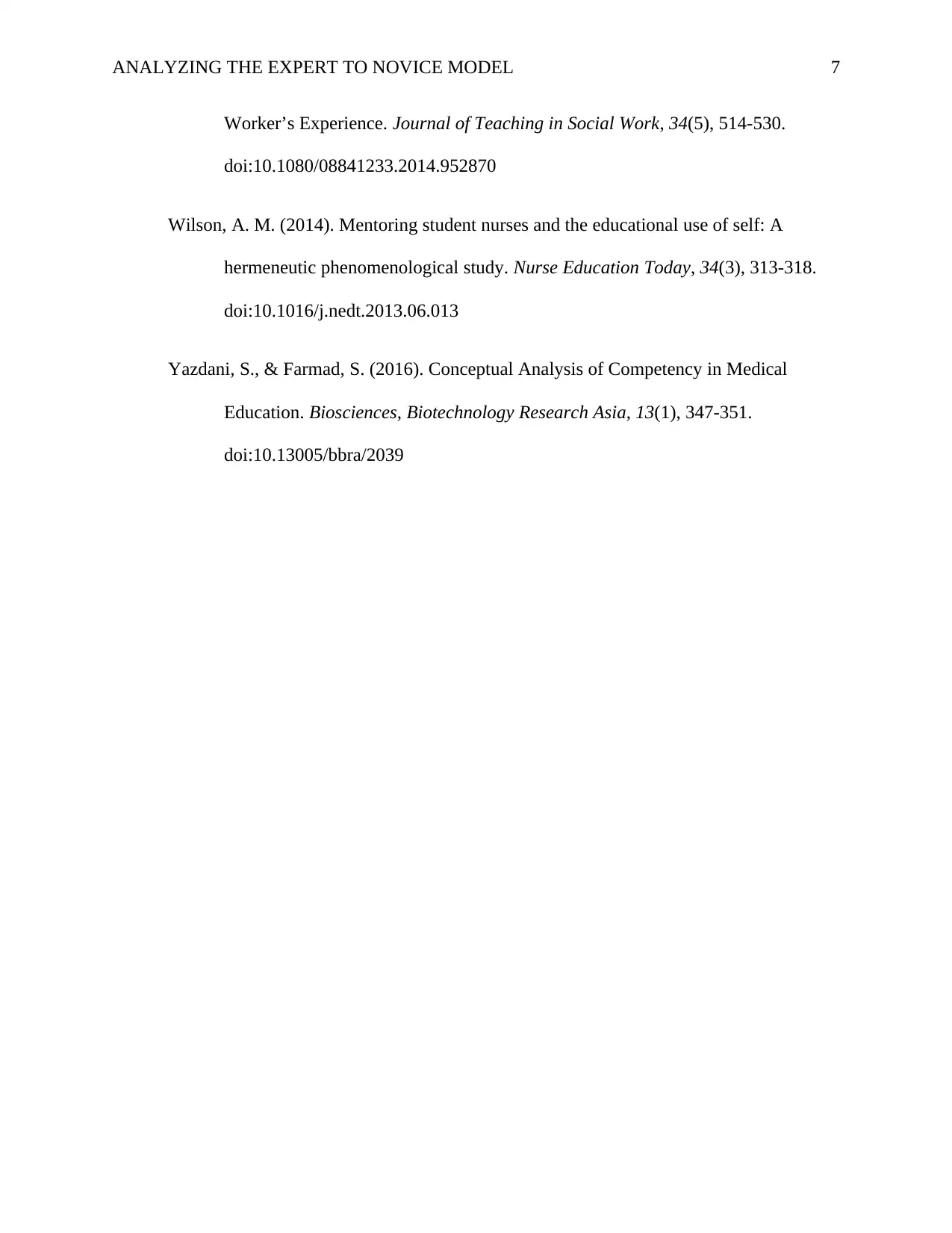
ANALYZING THE EXPERT TO NOVICE MODEL 7
Worker’s Experience. Journal of Teaching in Social Work, 34(5), 514-530.
doi:10.1080/08841233.2014.952870
Wilson, A. M. (2014). Mentoring student nurses and the educational use of self: A
hermeneutic phenomenological study. Nurse Education Today, 34(3), 313-318.
doi:10.1016/j.nedt.2013.06.013
Yazdani, S., & Farmad, S. (2016). Conceptual Analysis of Competency in Medical
Education. Biosciences, Biotechnology Research Asia, 13(1), 347-351.
doi:10.13005/bbra/2039
Worker’s Experience. Journal of Teaching in Social Work, 34(5), 514-530.
doi:10.1080/08841233.2014.952870
Wilson, A. M. (2014). Mentoring student nurses and the educational use of self: A
hermeneutic phenomenological study. Nurse Education Today, 34(3), 313-318.
doi:10.1016/j.nedt.2013.06.013
Yazdani, S., & Farmad, S. (2016). Conceptual Analysis of Competency in Medical
Education. Biosciences, Biotechnology Research Asia, 13(1), 347-351.
doi:10.13005/bbra/2039
1 out of 7
Related Documents
Your All-in-One AI-Powered Toolkit for Academic Success.
+13062052269
info@desklib.com
Available 24*7 on WhatsApp / Email
![[object Object]](/_next/static/media/star-bottom.7253800d.svg)
Unlock your academic potential
© 2024 | Zucol Services PVT LTD | All rights reserved.





